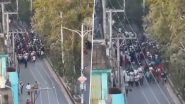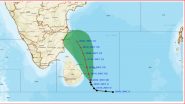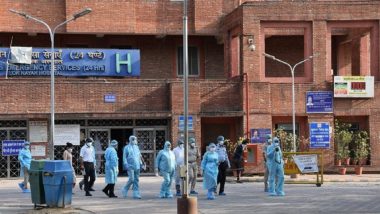New Delhi, May 21: On average, 1 in 7 Covid (14 percent) patients were hospitalised in India, during the second wave, higher than the western world where cumulatively 5 to 10 percent of COVID-19 positive patients have been hospitalized. According to research by Goldman Sachs on the state of the pandemic in India, it's difficult to ascertain currently if the delta is arising due to higher hospitalization requirements driven by the double mutant variant or these are more precautionary in nature.
US Epidemiology data presented by FDA, from early December-2020, also did show that weekly hospitalization rates reached 15 percent in the US in the 2nd wave. COVID-19 related hospitalizations are starting to dip but ICU occupancy remains high We have seen Covid related hospitalizations dip over the past week as caseload has reduced and recoveries/discharges have increased. If we were to go by the US experience of hospitalizations where the peak was in early January, India should see a substantial decrease in hospitalizations over the coming month. 'Corona Devi' Temple Built by Locals in Coimbatore to Defeat COVID-19 Pandemic.
Although the overall bed occupancy for all COVID-19 beds has dipped to 65 percent, ICU bed occupancy in key metros (especially in the South of India) remains critical, the report said. Goldman Sachs said Covid fatalities have disproportionately been among the elderly population (> 60 years) at 60 percent. If we were to include the adjacent cohort of 50 years, this proportion rises to 80%, given the multiple co-morbidities this population also suffers from, the report said. COVID-19 Vaccination Helpline Number: Centre Launches MyGov Corona Helpdesk For All Vaccination Related FAQs.
The report said state governments have ramped up COVID-19 bed capacity by over 3.3x in the past 75 days, led by higher allocations in both government and private facilities. In the 13 states tracked, COVID-19 bed capacity rose from 146k in early March to 486k by the middle of May.'We have seen COVID-19 related hospitalizations in India starting to dip over the past week and if the US experience is to go by, we could see significant improvements over the next month,' Goldman Sachs said.
Drug and oxygen shortages seem to be easing, led by a combination of increased domestic production, repurposing alternate sources as well as expedited imports. The testing protocol has been diversified with the addition of allied testing such as C-RP, D-Dimer, and CT Scans, to ease the load off RT-PCR capacity as well as serve as a cross-check given concerns around false negatives/lower sensitivity. Meerut Twin Brothers Lose Battle To COVID-19, Die Hours Apart From Each Other.
Vaccinations have been targeted at high-risk groups, which has yielded positive results. For instance, the case fatality rate has declined by more than half among those more than 50 years of age in the second Covid wave. This is encouraging, as vaccinations continue to roll out, the report said. The virus reproduction rate, which is a key epidemiological barometer, has fallen below the critical rate of 1, implying that the infection rate should continue to decline.
Apart from the unavailability of hospital beds, the second big challenge in April was the shortage of key drugs required for clinical management of Covid patients: Remdesivir and Tocilizumab. Most key manufacturers have stepped up production of Remdesivir and as per Ministry of Health data, monthly capacity has reached 10mn from 3.9mn at the beginning of April.
Cipla also noted during its Q4 earnings call, that with additional capacities coming online, the demand-supply gap has narrowed considerably. India has also placed an import order with GILD for 450K doses and received 75K recently. We have seen domestic growth seen a sharp surge in April (+53 per cent YoY) driven by COVID-19 related therapies: Favipiravir/Anti-infectives, Vitamins/Nutrients, and Gastrointestinal. Scientists Develop COVID-19 Protocols to Quickly Spot Mutants.
Although there was adequate production of oxygen in the country in the early part of April, only 15 percent of it was logistically linked to be used for medical purposes. The 2nd wave saw a sharp surge in medical oxygen requirements in April as cases picked up, leading to an acute shortage at healthcare facilities. Government action included production ramp-up from key suppliers, diverting oxygen from Industrial to medical purposes as well as placing import orders from surplus nations. Home COVID-19 Testing Kits to Be Available in Market in Next 3-4 Days, Says ICMR.
In phase 1 of the vaccination drive, vaccination has been targeted at healthcare and frontline workers as well as population above 50 years of age or with co-morbidities. The Ministry of Health also recently put out data on fatality rates in 2021 (vs. 2020) in the 2nd COVID-10 wave - the key conclusion is that in the high-risk group (more than 50 years of age), the case fatality rate has declined by more than half. This could potentially be explained by the progress achieved on vaccination.
India has currently 11 percent of the population that has taken the first dose and 3 percent that has taken the second dose. However, if we were to look at the high-risk individuals that the government has identified of c. 300mn (Healthcare, Frontline and Population more than 50 years or those with co-morbidities), the vaccination progress is better. A 40 percent of this group has already taken the first dose while 14 percent have been fully vaccinated.
(The above story first appeared on LatestLY on May 21, 2021 02:44 PM IST. For more news and updates on politics, world, sports, entertainment and lifestyle, log on to our website latestly.com).













 Quickly
Quickly













 RCB
RCB







